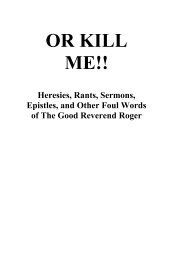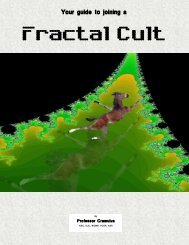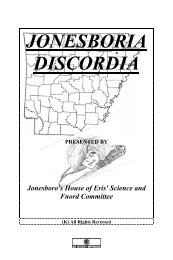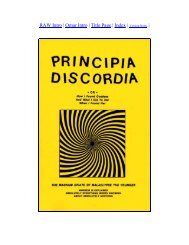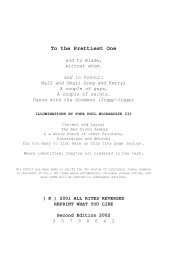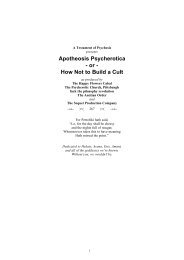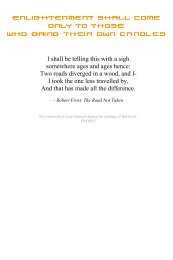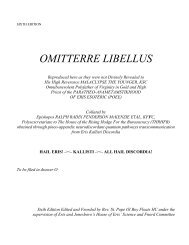Coincidance - Principia Discordia
Coincidance - Principia Discordia
Coincidance - Principia Discordia
Create successful ePaper yourself
Turn your PDF publications into a flip-book with our unique Google optimized e-Paper software.
COINCIDENCE 45<br />
Civilization, quoting a wide sampling of the best archeological evidence,<br />
argues persuasively that slavery was created after the subjugation of women<br />
and was probably inspired by it.<br />
In China, curiously, a very similar pattern has been discerned by contemporary<br />
scholarship. As Joseph Needham demonstrates in a remarkable sixvolume<br />
study, Science and Civilization in China, the matrist and matriarchal values<br />
vvere preserved in that remarkable text, the Tao Te Ching, which praises a<br />
figure quite cognate with the great goddess of the Mediterranean area:<br />
The Valley Spirit never dies<br />
She is called the Eternal Woman<br />
and urges all the usual matrist qualities already listed in the table from G.<br />
Rattray Taylor. Needham concludes that Chinese culture, before the Chou<br />
dynasty, was probably matrilineal and vaguely along the lines of Bachofen's<br />
classic matriarchies.<br />
Even after the rise of the patriarchal governing class, women retained<br />
most of their traditional rights in Sparta until well within historical times.<br />
(Plato, whose Republic is considered pro-Spartan propaganda by some<br />
historians, included equality for women in his ideal nation, along with such<br />
other Spartan institutions as state socialism and lamentable Stalinist<br />
censorship of the arts.) Even in Athens, where the wives were reduced to a<br />
condition only slightly above that of the slaves, the courtesan class had most<br />
of the freedom enjoyed by nonslave males. The Athenians seem to have<br />
made the great divorce between sexual love and sexual reproduction that<br />
characterizes so many later societies. Their lyric poems are almost always<br />
written to courtesans or to young boys; they never seem to have felt<br />
romantic about the women who mothered their children.<br />
Throughout these first pagan patriarchies, however, love and sex were<br />
still enjoyed and praised as great ornaments of life and inextricably<br />
connected with the religious life. The Old Testament, like the popular<br />
marriage manuals circa 1920-1960, glorifies sex in marriage as the highest<br />
of human joys—and does not neglect the breasts. ("Rejoice with the wife of<br />
thy youth ... Let her breasts satisfy thee at all times," Proverbs 5:18-19.)<br />
The Song of Solomon even seems to the literal-minded reader, to be<br />
praising fornication—but subtle rabbis and Christian theologians have<br />
repeatedly argued that it means quite the opposite of what it appears to say.<br />
(Actually, as Robert Graves has noted, the Song looks very much like the<br />
chants which accompanied rites of fertility-magic in the old matriarchal<br />
religion or in the still-surviving witch cult.)<br />
Early Egyptian religion, it might be noted, was largely sexual in basis and



